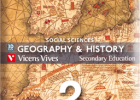The Earth's Population
The science that studies population is called demography. Demography analyses the size, structure and distribution of populations. It is also concerned with changes that affect populations over time due to factors such as birth rate, mortality rate and migrations. [...]
Esta secuencia contiene:
-
12 actividades
-
63 recursos
-
Idioma:
- Inglés
-
Formato:
Interactivo
Secuencia didáctica
-
Didactic objectives Understand the factors that influence the distribution of the population on Earth. Define the concept of population density. Explain the evolution of the world population. [...]
-
1. The distribution of the global population Population density measures how many inhabitants (inhab.) live in one square kilometre. This measurement is expressed as inhab./km2. There are about 7 billion inhabitants on the Earth. [...]
-
The science that studies population is called demography. Demography analyses the size, structure and distribution of populations. [...]
-
1.1. Population distribution There are about seven billion inhabitants on the Earth. However, they are distributed unevenly around the world. Population density measures how many inhabitants (inhab.) live in one square kilometre. [...]
-
Population density measures the number of inhabitants per square kilometre (inhab./km2), assuming an even distribution of population across the territory:
-
In general, the world population grew slowly until the middle of the 17th century. After that, it began to grow quickly, especially in the 20th century. 2.1. [...]
-
3.1. Population dynamics The main factors that cause populations to change are: Birth rate. This is the number of births in a population in a year. Mortality rate. This is the number of deaths in a population in a year. [...]
-
A population pyramid is a graph that shows the structure of a population by age and gender. A population pyramid includes the following elements: Age groups. Each age group covers five years, beginning with 0-4 years and ending with 85+. [...]
-
4.1. Emigrants and immigrants Migration, or the movement of inhabitants from one area to another, greatly influences population. Emigration is when people leave their native country to live in another. [...]
-
5.1. The active and inactive population When analysing a country's development, we study the relationship between the population and work. There are two types of population: The active population. [...]
-
The science that studies population is called demography. Demography analyses the size, structure and distribution of populations. [...]
-
The science that studies population is called demography. Demography analyses the size, structure and distribution of populations. [...]
Cursos y asignaturas
-
13 años:
- Historia
- Geografía
-
14 años:
- Historia
- Geografía
-
Aún no hay comentarios, ¡comparte tu opinión! Inicia sesión o Únete a Tiching para poder comentar
La licencia digital es una autorización que permite utilizar un recurso digital de acuerdo con las condiciones legales de dicho recurso. El código que recibas una vez la hayas comprado te permitirá acceder al recurso educativo digital elegido.
Puedes consultar más información en nuestra página de ayuda.






































































¿Dónde quieres compartirlo?
¿Quieres copiar el enlace?